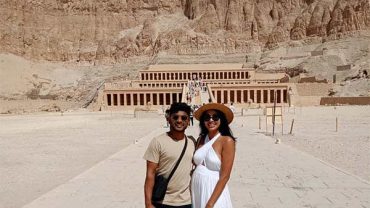Nestled on the east bank of the Nile River in the heart of Egypt lies a marvel that transcends the boundaries of time – the Luxor Temple Complex. This archaeological gem, dating back over 3,400 years, stands as a testament to the grandeur of ancient Egyptian civilization. As we embark on a virtual journey through this historical oasis, the very mention of “Luxor Temple Complex” beckons us into a realm where the past unfolds like the delicate petals of a lotus, revealing the rich tapestry of a bygone era.
A Glimpse into Ancient Majesty
As one ventures into the Luxor Temple Complex, the sheer magnitude of its architectural prowess becomes evident. Dedicated to the rejuvenation of kingship and the veneration of the divine, this sprawling complex comprises several structures, each with its unique significance. The Great Court, an expansive area enclosed by colossal colonnades, sets the stage for the majestic grandeur that awaits within. Towering statues of pharaohs guard the entrance, their stoic gazes seemingly transcending time.
The Avenue of Sphinxes, a grand processional pathway, connects the Luxor Temple to the Karnak Temple, underscoring the symbolic and ritualistic importance of this sacred space. The precision with which these avenues were constructed reflects the ancient Egyptians’ sophisticated understanding of urban planning and their devotion to harmonizing the earthly with the celestial.
The Spiritual Nexus
Beyond its architectural splendor, the Luxor Temple Complex is a spiritual nexus, a place where mortals sought communion with the divine. The Hypostyle Hall, adorned with intricately carved columns and celestial scenes, stands as a testament to the religious ceremonies that once echoed through its hallowed halls. Each column, adorned with hieroglyphics and divine imagery, tells a story of devotion and a quest for spiritual transcendence.
The temple’s core is dedicated to the veneration of the Theban Triad—Amun, Mut, and Khonsu—a trio of deities central to the religious pantheon of ancient Thebes. The Sacred Lake, a serene basin within the complex, served as a ritualistic pool for ceremonial ablutions, symbolizing purification and spiritual rebirth.
Preservation Efforts and Global Significance
In the 19th century, the Luxor Temple Complex became the focus of international attention as European archaeologists embarked on a mission to uncover its mysteries. Today, it stands not only as a symbol of Egypt’s rich cultural heritage but also as a testament to the collaborative efforts of the global community to preserve and understand the past.
UNESCO, recognizing the profound historical significance of Luxor, designated the entire city as a World Heritage Site. The ongoing conservation endeavors ensure that future generations can continue to marvel at the architectural prowess of the ancients and delve into the spiritual tapestry woven within these sacred walls.
Timeless Beauty in Modern Exploration
As we stand before the Luxor Temple Complex today, its stones weathered by the winds of millennia, there is an undeniable sense of awe and reverence. The site continues to be a source of inspiration for artists, historians, and archaeologists alike. Modern explorers, armed with technological advancements and a deep respect for the past, unravel new layers of understanding, bringing forth revelations that further enrich the narrative of Luxor’s enduring legacy.
Tourism and Cultural Exchange
In the 21st century, the Luxor Temple Complex has evolved into a thriving hub of cultural exchange. Welcoming visitors from around the world, the site has become a living testament to the power of shared heritage. Tourists, historians, and enthusiasts flock to Luxor, drawn by the allure of its ancient mystique and the opportunity to walk in the footsteps of pharaohs.
Local communities, recognizing the economic and cultural value of this historical treasure, actively participate in the preservation efforts and the promotion of sustainable tourism. The bustling markets and vibrant streets surrounding the Luxor Temple Complex provide a glimpse into the intersection of ancient traditions and contemporary life, creating a harmonious blend that enriches the overall experience for visitors.
Light and Sound Spectacle
As the sun dips below the horizon, a new dimension of enchantment unfolds at Luxor. The Light and Sound Spectacle, a captivating audiovisual experience, casts the ancient stones in a kaleidoscope of colors, narrating the tales of pharaohs and gods. This immersive storytelling brings the history of the Luxor Temple Complex to life, captivating audiences and fostering a deep appreciation for the cultural legacy it embodies.
The play of light and shadow on the temple’s monumental structures creates a surreal ambiance, transporting spectators to a time when these very stones bore witness to the rituals and celebrations of a civilization that once flourished along the banks of the Nile.
Future Prospects and Collaborative Research
In an era where technological advancements continually reshape our understanding of the past, Luxor remains a focal point for collaborative research. Archaeologists, historians, and scientists employ cutting-edge techniques, from 3D modeling to ground-penetrating radar, to unveil hidden secrets buried beneath the sands. This interdisciplinary approach ensures that the Luxor Temple Complex continues to contribute to our comprehension of ancient Egyptian society.
International partnerships, facilitated by a shared commitment to unraveling the mysteries of Luxor, foster a sense of unity among researchers. The collaborative spirit transcends geographical boundaries, emphasizing the global significance of preserving and understanding our collective heritage.




Comment (0)